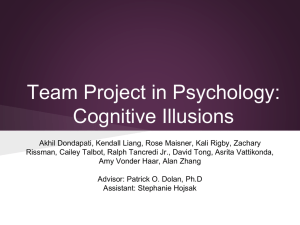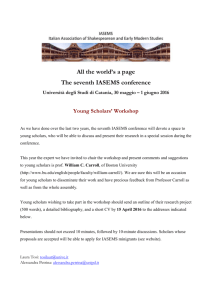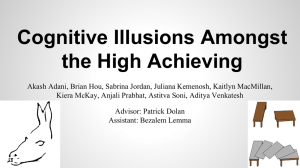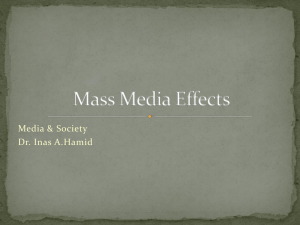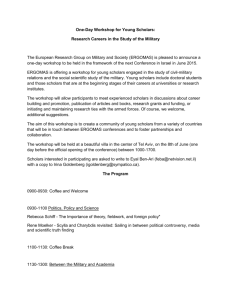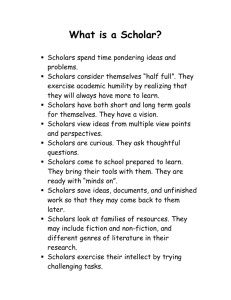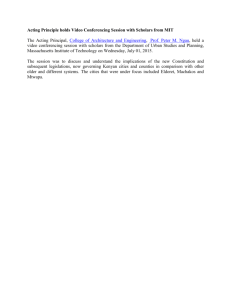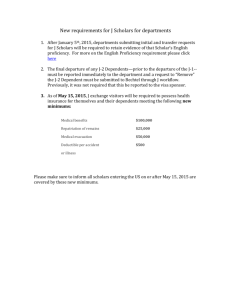T2 Final Paper - Drew University
advertisement
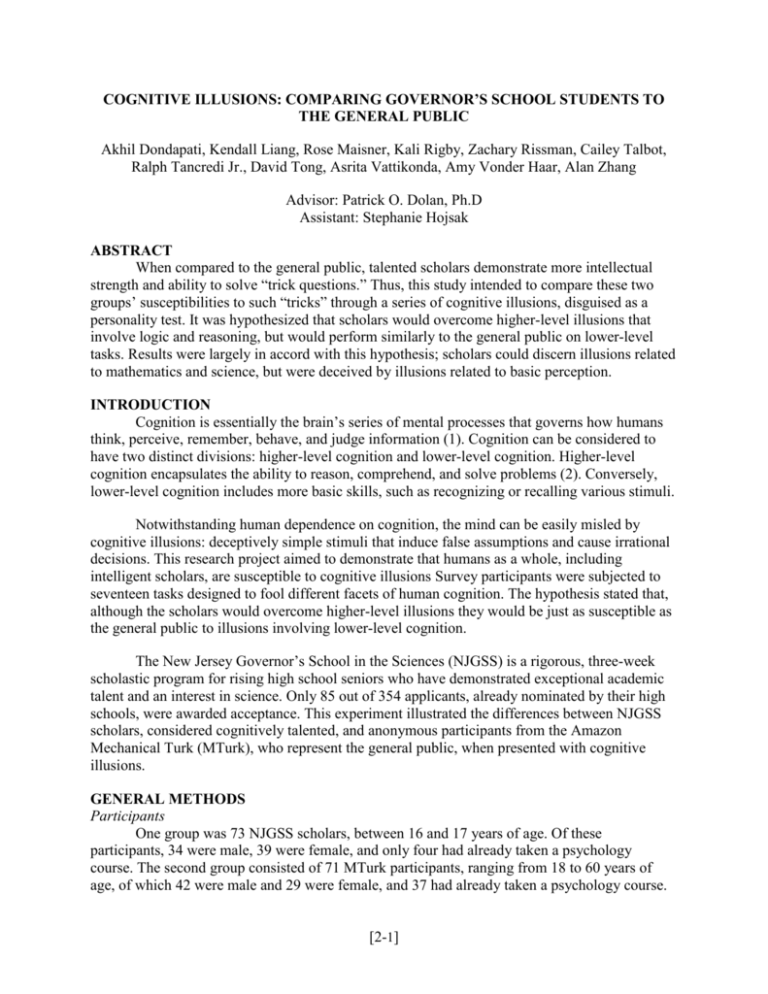
COGNITIVE ILLUSIONS: COMPARING GOVERNOR’S SCHOOL STUDENTS TO THE GENERAL PUBLIC Akhil Dondapati, Kendall Liang, Rose Maisner, Kali Rigby, Zachary Rissman, Cailey Talbot, Ralph Tancredi Jr., David Tong, Asrita Vattikonda, Amy Vonder Haar, Alan Zhang Advisor: Patrick O. Dolan, Ph.D Assistant: Stephanie Hojsak ABSTRACT When compared to the general public, talented scholars demonstrate more intellectual strength and ability to solve “trick questions.” Thus, this study intended to compare these two groups’ susceptibilities to such “tricks” through a series of cognitive illusions, disguised as a personality test. It was hypothesized that scholars would overcome higher-level illusions that involve logic and reasoning, but would perform similarly to the general public on lower-level tasks. Results were largely in accord with this hypothesis; scholars could discern illusions related to mathematics and science, but were deceived by illusions related to basic perception. INTRODUCTION Cognition is essentially the brain’s series of mental processes that governs how humans think, perceive, remember, behave, and judge information (1). Cognition can be considered to have two distinct divisions: higher-level cognition and lower-level cognition. Higher-level cognition encapsulates the ability to reason, comprehend, and solve problems (2). Conversely, lower-level cognition includes more basic skills, such as recognizing or recalling various stimuli. Notwithstanding human dependence on cognition, the mind can be easily misled by cognitive illusions: deceptively simple stimuli that induce false assumptions and cause irrational decisions. This research project aimed to demonstrate that humans as a whole, including intelligent scholars, are susceptible to cognitive illusions Survey participants were subjected to seventeen tasks designed to fool different facets of human cognition. The hypothesis stated that, although the scholars would overcome higher-level illusions they would be just as susceptible as the general public to illusions involving lower-level cognition. The New Jersey Governor’s School in the Sciences (NJGSS) is a rigorous, three-week scholastic program for rising high school seniors who have demonstrated exceptional academic talent and an interest in science. Only 85 out of 354 applicants, already nominated by their high schools, were awarded acceptance. This experiment illustrated the differences between NJGSS scholars, considered cognitively talented, and anonymous participants from the Amazon Mechanical Turk (MTurk), who represent the general public, when presented with cognitive illusions. GENERAL METHODS Participants One group was 73 NJGSS scholars, between 16 and 17 years of age. Of these participants, 34 were male, 39 were female, and only four had already taken a psychology course. The second group consisted of 71 MTurk participants, ranging from 18 to 60 years of age, of which 42 were male and 29 were female, and 37 had already taken a psychology course. [2-1] Materials The survey was administered through Qualtrics, an online tool for data collection. All stimuli and questions can be found in the Appendices. Design The survey was designed to resemble a personality test, laden with “filler” questions corresponding to both social desirability and the P-E-N model of personality traits developed by Hans Eysenck: psychoticism, extraversion, and neuroticism (3). Distribution The survey was administered to NJGSS scholars in four half-hour sessions on Saturday, July 19. Each session included approximately twenty scholars and was supervised by members of the team project. Participants were provided with an anonymous survey link. MTurk participants were paid a dollar for their time on Sunday, July 20 between 1:00 and 2:00 A.M EST. Statistical Analysis Statistical t-tests determined whether the discrepancies between the scholars’ results and the general public’s results occurred due to chance, or to a true difference between the populations. Using a two-sample, unequal variance t-test to compare the two means, a p-value (probability value) was calculated. Assuming normal distribution, p-values less than 0.05 showed there was an extremely low likelihood that chance was responsible for the differences between the two means. For example, if a p-value of 0.005 was calculated, the probability that statistical differences occurred due to chance is one in two hundred. SPECIFIC METHODS AND RESULTS Individual Tasks: Sensation, Perception, and Attention Tabletop Illusion Although the two parallelograms in the tabletop illusion have identical dimensions, they are universally reported to look different, perhaps because the brain perceives the image as threedimensional (4) (Appendix A). The table legs give a sense of depth, and thus the vertical table appears longer, with its back end appearing further away than that of the horizontal table. This phenomenon is known as size-constancy expansion: the perceived expansion of space with apparent distance (5). The prediction was that NJGSS scholars would be equally as susceptible to the illusion as the general public. A simplified forced-choice version of the task (6) (Appendix A) was created. Participants were presented with “Standard” and a choice of two other boxes, all of which had their top surfaces shaded in red. One choice’s red surface was identical in dimensions to the standard (drawn vertically and perceived to look longer due to size-constancy expansion), while the other was not (drawn horizontally and perceived to be the same). Participants were prompted to choose which red surface had the same dimensions as the “Standard.” They were also given the option to choose neither. Two versions of the test (one with choice A as the correct answer and one with choice B as the correct answer) were created in order to counterbalance any influence of proximity of the correct choice to the standard. Only one version was presented to each participant. [2-2] The average percentages of correct responses for NJGSS scholars and MTurk participants were quite low and approximately the same: 16% and 17%, respectively. This was consistent with the hypothesis, showing that the scholars were equally as vulnerable to this low-level perception task as the general public. Ambiguous Picture An ambiguous picture is an image that can be perceived in at least two valid ways. With ambiguous pictures, the responses of NJGSS scholars and the general public were compared with respect to cognitive filters: mental categories that sort visual input to expedite the process of reaching a perceptual conclusion. A perceptual filter is a low-level cognitive filter that activates previously obtained mental categories related to an image’s physical qualities (color, shape, and luminance.) Conversely, a conceptual filter activates categories related to semantic overlap, categorical similarity, or meaning related to the input—e.g. on Easter Sunday, people are more likely to be preoccupied with the Easter Bunny (Appendix B). There is a pre-existing bias from the significance of Easter in people’s minds that makes them more likely to perceive the rabbit in the rabbit-duck ambiguous picture. Both filters serve to reduce ambiguity and create a more discrete image (7). In the experiment, these cognitive filters were used in attempt to prime participants’ perception of an ambiguous picture. To test this phenomenon, each participant was first asked whether they would like an elephant, macaw, or a snake/seal/donkey as a pet. The snake served as the control, as it was biasneutral, while the seal and donkey were the experimental variables. Shortly afterwards, a donkey-seal ambiguous picture was flashed for exactly three seconds, and participants were asked to name the animal they just saw. The prediction was that NJGSS scholars would be less susceptible, but a greater percentage of scholars would be able to perceive both animals rather than only the priming animal. Because their higher level of general cognition enables scholars to be more alert and skeptical, they would probably notice more. However, this does not necessarily imply complete immunity to the priming; it is expected that, at minimum, a significant majority of them would perceive the primed animal. Figure 1: Ambiguous Picture - Reported Donkey Figure 2: Ambiguous Picture - Reported Seal The results demonstrate that NJGSS scholars were more susceptible to priming and cognitive filters. When primed with the snake control, 56% of NJGSS scholars saw the donkey, while 76% of scholars primed with the donkey saw the donkey (Fig 1). However, 90% of the [2-3] general public who were primed with the neutral snake saw the donkey, while 96% of those primed with the donkey saw the donkey. Along with the seal priming data, these findings suggest that priming had a stronger effect on NJGSS scholars than on the general public (Fig 2). Due to their intelligence and cognitive talent, NJGSS scholars may be more aware than the general public. This heightened observance of particular stimuli, such as the priming pictures, may have biased their perceptual and conceptual filters towards perceiving the primed animal. As such, it follows that the general public may not be as attentive and consequently, as vulnerable to these filters. McGurk Effect The McGurk Effect, first described by McGurk and MacDonald in 1976, demonstrates visual input’s effects on auditory perception (8). Humans are visually dominant; when sensory messages conflict, the visuals take precedence and can ultimately determine what sounds are perceived (8). The McGurk Effect exposes participants to the sound “ba,” a neutral syllable that is easily confused upon addition of a conflicting visual, such as a person mouthing “fa.” Most participants will hear the sound implied by the visual rather than the actual audio. Neither awareness nor differences in language/gender affect the results of the McGurk Effect (9). Participants were randomly shown only one of two different McGurk videos. One video, the control, comprised both a “ba” audio clip synced with a “ba” video, while the other had a “ba” audio synced with a “fa” video. Each participant was asked to write the sound they heard. The results were consistent with the hypothesis that NJGSS scholars would be just as susceptible to lower-level perceptual cognitive illusions (Table I). Table I: McGurk Effect Results NJGSS “fa” video Reported “ba” 17% Reported “fa” 77% Both “fa” and “ba” 6% Discarded Data - NJGSS “ba” video 86% 6% 8% - General Public “fa” video 11% 84% 5% - General Public “ba” video 94% 6% Both NJGSS scholars and participants from the general public were tricked almost equally by the “fa” video, with slightly fewer NJGSS scholars falling for the illusion. The best explanation for this could be due to skepticism. Scholars may have closed their eyes and watched, not trusting the personality test guise. On similar note, fewer scholars than general public participants reported correctly on the “ba” video. This may show how the scholars’ innate skepticism and distrust of the task caused them to make simple mistakes. In this case, since they reacted to the illusion equally compared to the general public, their intelligence actually hurt them on this task. The general public likely thought more simply and therefore answered correctly, proving the scholars’ tendency to overthink. Also, more scholars caught the trick and wrote down both syllables, though the difference was small. Overall, the general public did well with this task relative to the scholars, especially when it came to not over thinking the “ba” video. In fact, the differences between the two groups were minor, proving that cognitive talent does not improve imperviousness to the McGurk Effect. [2-4] Change Blindness Change blindness, first tested by Levin and Simons in 1997, occurs when a change in visual stimuli is not registered by the observer. In a staged scene with several intentional editing mistakes, most observers normally do not notice any changes, and it usually takes many changes in the visual before the observer notices. Change-detection failures occur not only when the changes are in random locations of the scene, but also when change occurs in an object that is the center of attention. To recognize a change, the observer must pay close attention to the changing object before and after the change occurs. This suggests that changes to objects that are central in a scene will be noticed more quickly—a hypothesis that is supported by several studies. However, even changes in central objects cannot be noticed without careful attention and extensive processing by the viewer (10). In this survey, the participants were shown a video containing nine visual editing mistakes, such as the disappearance of a woman’s scarf and a change in plate color (Appendix D). They were then asked to describe anything “unusual,” meaning editing mistakes. Half of the participants were instructed to pay attention to possible changes in the scene, while the other half received no prior instruction. Both NJGSS and MTurk participants who were not warned about changes noticed no changes. Among scholars instructed to look for changes, 50% noticed at least one change. The maximum noticed by a single person was three changes and the average was 1.55. Only 34% of participants from the general public who were warned of editing mistakes actually noticed changes. The maximum number noticed was also three changes, but the average number noticed was 1.31. The most commonly noticed mistake was the disappearance of the woman’s scarf, which occurred center-screen, and was noticed by 77% of the NJGSS scholars but by only 54% of the corresponding general public participants. More NJGSS scholars than the MTurk participants noticed changes, implying that NJGSS scholars possess more focused attention. Since humans cannot process information about every object in the scene, they focus their attention on the principal or central objects. This study confirms that change detection relies on attention. However, since every participant missed many changes, it can be assumed that more than attention is required for change detection. Individual Tasks: Memory Penny Memory Test In 1979, Nickerson and Adams tested memory’s fallibility. When asked to recall a penny’s details, many U.S. citizens had difficulty (11). The “Penny Memory Test” asks participants to choose the correct United States penny from 15 options with different combinations of features. This test shows that the brain records only information that will be useful daily. In this case, the brain encodes enough to be able to distinguish a penny from other coins, so color and approximate size, but not minute details, are remembered (12). Participants were asked to choose the single, correct United States penny from 15 similar options. These 15 options all had the same dimensions and coloring, but each penny had a different combination of features, including the date, phrasing, and direction of the silhouette (Appendix E). There was only one correct United States penny. [2-5] The correct penny was chosen by 35% of NJGSS scholars and 54% of the general public. Submitting these values to a two-sample unequal variance t-test confirmed that this difference is statistically different (p < 0.03). The general public could be more aware of the details of a penny since their average age was higher meaning they have had more experience with pennies, but this difference may be due to the participants from the general public cheating. It would have been easy for them to simply look at a penny before answering. Scholars’ data is more consistent with Nickerson’s original report that 42% of participants chose the correct penny, further discrediting the MTurk data (11). Moses Illusion The Moses illusion, first developed by Erikson and Mattson in 1981, employs a question that is intentionally, yet subtly, distorted to make it unanswerable. The question, “How many animals of each kind did Moses bring onto the ark?” is a common example of this illusion. In this example, most people answer “two”, even though they know that Noah brought animals onto the ark, not Moses (13). The most plausible explanation for this phenomenon is that the participant begins reading the question, assumes he or she knows its content, and therefore answers the question without reading the distorted portion of the question (14). The Moses illusion section of the personality test was introduced as a “lightning round,” telling participants to move quickly in order to discourage them from rereading questions and thus skewing the results. First, the participants were asked two easy, similarly-formatted questions (Appendix F). Then, one of two randomly selected Moses illusion questions was presented. One of these questions was “What shape has a circumference of πr2?” whose expected answer of “circle” is incorrect. Similarly, the other question was “What is the name of the man in the red suit and long white beard who rides a sleigh and gives out birthday presents?” whose expected answer of “Santa Claus” is also incorrect. The prediction was that NJGSS scholars would notice the mistake in the math-related question more than the general public, but that both groups would equally fall for the illusion on a non-academic question. The results show that for the Santa question, NJGSS scholars and MTurk participants scored very similarly, with 76% of NJGSS scholars, and 72% of the general public incorrectly reporting “Santa.” A two-sample t-test confirmed that these values did not differ significantly (p > 0.75). However, the results show that for the circle problem, NJGSS scholars scored much better than the general public did, with only 28% of NJGSS scholars reporting circle, compared to 68% of the general public. A 2 sample t-test confirmed that this difference is significant (p < 0.001). Together, these results suggest that NJGSS scholars are much more perceptive in math and science than the general public, but are very similar to the general public in non-academic areas. False Memory (DRM) The Deese-Roediger-McDermott (DRM) paradigm involves the false memory phenomenon, in which participants remember events that did not actually occur. Developed by Deese in 1959, the procedure became well-known only after the work of Roediger and McDermott in the 1990s. Deese orally presented undergraduate students with lists of twelve words, all of which were related to a critical word, or lure, that was unrepresented in the list. He found that students recalled the critical word about 44% of the time (15). Roediger and [2-6] McDermott later obtained similar results and speculated that the constructive nature of memory led to the phenomenon (16). The participants were shown a list of fifteen words related to medical professions, with the lure word being “doctor.” Then, while the list was still visible, participants were prompted to choose their favorite word and rate the overall pleasantness of the list. Not only did this ensure participants read the entire list carefully, it also tied into the pretense that the survey assessed personality. The final task, on the next screen, asked participants to recall as many words as possible. The prediction was that NJGSS scholars will be no less susceptible to the false memory phenomenon than the general public. Reading one word from a list generates non-specific memories in that the words are presented in the same manner and involve the same topic. Therefore, NJGSS scholars were expected to include “doctor” as frequently as the general public. NJGSS scholars were just as susceptible to the false memory phenomenon as the general public, with each group recalling “doctor” 55% of the time and 56% of the time, respectively (Table II). However, NJGSS scholars were more adept at correctly remembering words from the list. NJGSS scholars remembered, on average, 6.25 correct words whereas the general public remembered 5.03 correct words. A two-sample t-test confirmed that this difference is significant (p < 0.002). Thus, it could be argued that, although NJGSS scholars are equally susceptible to false memory, they are relatively better at remembering in general. Table II: False Memory (DRM) Results “Doctor” Remembered Number of Correct Words (Average) NJGSS Scholars 55% 6.25 General Public 56% 5.03 Number of Incorrect Words (Average) 0.10 0.14 Individual Tasks: Judgment and Decision Making Linda Problem A conjunction fallacy occurs when, given multiple options, one assumes that a conjunction is more probable than one of its constituents (17). Tversky and Kahneman developed the Linda problem, which demonstrates conjunction fallacy (Appendix I). The majority of participants choose the conjunction as most probable (17). In answering the Linda problem, people will often use representativeness, a judgmental heuristic device. Due to representativeness, participants tend to choose the conjunction because it seems more “representative” of Linda based on her description, rather than apply extensional probability reasoning (18). This illusion demonstrates that people often use intuition and experienced-based techniques, rather than logic and mathematical probability. To test whether NJGSS scholars, people especially strong in mathematics and science, would be more or less susceptible to this illusion, the Linda problem was included in the alleged personality assessment. First, participants were provided with a description of Linda (Appendix H). Then, the participant was asked to rank from a list of the three choices which occupation Linda most likely held, from most to least likely. These occupations included a bank teller, an activist in the feminist movement, or both. [2-7] The prediction was that the NJGSS scholars would be less susceptible to choosing the conjunction rather than one of the single condition choices. Since NJGSS scholars are particularly strong in mathematics, they would be more likely to see that a conjunction is less probable than the two single, separate condition choices. However, some NJGSS scholars would still choose the incorrect answer, because they are susceptible to heuristic devices such as representativeness. It is equally probable that Linda will be a bank teller or active in the feminist movement. The general public would be more susceptible to the conjunction fallacy because it would be likely that they were not as mathematically skilled as NJGSS students. As a result, their likelihood of choosing the conjunction via judgmental heuristics instead of extensional probability reasoning was higher. Table III: Linda Problem Results Correct NJGSS Scholars 12% General Public 18% Wrong 88% 82% The results did not support the prediction. The general public was actually slightly more likely to get the problem correct, though the difference didn’t reach statistical significance (p = 0.32). In both populations, most participants still chose the conjunction fallacy over the less representative constituent (Table III). This can be attributed to the representativeness heuristic, where people use intuition and experience to answer questions and make assumptions, rather than applying extensional probability reasoning to solve this problem, which utilizes mathematical frequency (17). The question was worded so participants would not think mathematically; the participants were asked which choice was more “likely”, rather than which was more “probable”. This difference in connotation may have caused the participants to momentarily disregard the rules of probability. Coin Toss In 1972, Tversky and Kahneman also explored the representativeness heuristic through questions about coin tosses and probability (19). Most participants, when asked to determine the likelihood of the sequences HTHTTH, HHHHTH, and HHHHHH, selected HTHTTH based on their preconceived notion that coin tosses are random; however, each coin toss is independent of the others. The definition of independent events indicates that each series is equally likely. The participants chose what looked random rather than what followed the rules of probability. The prediction was that a higher percentage of the NJGSS scholars would correctly answer the coin toss problem that any series of six coin tosses is equally likely. Scholars aware of the laws of independence would be more likely to state that both options are equally likely. However, some might feel that they must choose a single answer, even if they knew the correct answer. The general public would be more susceptible to this cognitive illusion. Since the participants may not have an understanding of independent events, they might choose the option that appeared most random. For this problem, the participants were asked which of two series of six coin tosses was more likely. One appeared random, while the other appeared ordered. Each participant had the option of typing in an answer, rather than simply selecting from two incorrect answers, as was [2-8] done in the original Tversky and Kahneman experiment. This enabled the participants to answer that both events were equally likely in addition to the individual choices, A and B. Table IV: Coin Toss Results HTHHTT HHHHHH Both Are Equally Likely NJGSS General Public 4% 4% 44% 4% 52% 92% The majority of NJGSS students fell for this illusion and believed that the random series, HTHHTT, was more likely (Table IV). Close in second was the answer, “both are equally likely.” (Table IV). This indicates that, while some NJGSS students knew about the independence of individual coin tosses, others were still susceptible to this cognitive illusion. The participants from the general public performed as expected: an overwhelming majority, 91.55%, believed that the random series was more likely. Relative to NJGSS scholars, very few responded correctly. The difference in correct responding between the two groups was statistically significant (p < 0.001) Hospital Illusion Tversky and Kahneman continued their research of the representative heuristic in a 1974 study (18,20) (Appendix J). From a group of 95 undergraduate students, 56 believed that both hospitals would record a similar number of such days (within 5%) (18). This problem illustrates that certain individuals disregard crucial information, such as hospital size. The correct answer is the smaller hospital, yet a majority of participants believe that both hospitals are representative of the population and that the number of days with male births over 60% must be fairly similar. The prediction was that, for the most part, students would not fall for this illusion, due to its mathematical nature. Some may be tricked by not reading into the problem enough; they may just assume that the days with male births over 60% are within 5% of each other. The general public includes individuals whose strong suits are not necessarily math or science; therefore, according to the prediction, most of the MTurk participants would incorrectly answer “within 5% of each other.” This illusion does not clearly indicate that it should be looked at through a mathematical lens, so the general public may view the number of births at each hospital as extraneous information. The participants were able to select either the larger hospital, the smaller hospital, or both will record a similar number of days (within 5%). Table V: Hospital Illusion Results Large NJGSS 7% General 31% Public Small 56% 21% Both (Within 5%) 37% 48% [2-9] The hospital problem’s results were similar as to what was expected, as 56% of the NJGSS participants answered correctly, compared to only 21% of the MTurk participants (Table V). A two-sample t-test confirmed that this difference is statistically reliable (p < 0.001). Due to their affinity for math and science, it would be expected that NJGSS scholars perform better on this task. Anchoring When asked to make estimates, humans often gravitate towards an initial piece of information, which could be completely arbitrary—e.g. the last two digits of one’s social security number—or even suggested by the wording of the question. Decision-makers then tune these initial values to arrive at their estimations; however, during this “anchoring-and-adjusting” phase, the anchor exerts such an influence that adjustments are insufficient, and nearly all final answers are biased towards the initial values (18). To test participants’ susceptibility to the anchoring effect, questions were posed and worded so as to emphasize specific anchors (Appendix L). They were later asked to make an estimate with no prior information besides the anchor. The prediction was that both NJGSS scholars and the general public would be equally susceptible to the anchoring effect insofar as any participants who were exposed to lower anchors would most likely make lower estimates, while those who were exposed to larger anchors would most likely make higher estimates. In both cases, the anchor would have biased participants’ judgments because the questions referenced uncommon knowledge. Figure 3: Gandhi Anchoring Results Figure 4: Tanzania Anchoring Results Because both groups of participants were strongly influenced by anchoring and displayed a clear bias in their answers, the results were consistent with the hypothesis (Fig. 3,4). A t-test pvalue less than 0.04 confirmed that NJGSS scholars were far less swayed by the anchoring effect with Gandhi because they probably knew his age or had keener reasoning skills than MTurk participants. It can be concluded that when individuals are forced to make estimates about an unfamiliar topic—in this case, the climate of an unfamiliar country—they will be susceptible to the anchoring-and-adjusting effect regardless of their cognitive potential. When there is little to no foundation necessary to make a rational, logical, and accurate decision, humans must instead resort to heuristics (21). [2-10] Intuitive Physics Humans have developed their own ideas about physics based on their interactions with the world. This topic was first studied by Michael McCloskey, who concluded that when humans see objects in motion, they create their own explanations for how and why objects move in the manner they do. Human reasoning is often incorrect (22). By asking participants to predict the trajectory of an object in motion, these self-created explanations can be examined. Participants were given a multiple choice question asking them to predict the trajectory of a ball dropped from a moving plane (Appendix L). Table VI: Intuitive Physics Results NJGSS Scholars Ball follows parabolic path forward (correct) 70% Completion of a Physics Course 73% General Public 35% 45% A two-sample t-test confirmed that the difference in accuracy between the two groups was statistically significant (p < 0.001). Results for the remaining NJGSS scholars were as follows: 2% predicted the ball would drop diagonally, 14% predicted the ball would drop parabolically backwards, and 14% predicted the ball would drop straight down. In the general public, 7% predicted the ball would drop diagonally, 38% the ball would drop backwards, and 20% predicted the ball would drop straight down (Table VI). However, there was a greater percentage of test participants in the general public who answered the question incorrectly despite having taken a physics course (Table VI). These results showed that enhanced aptitude in the sciences does provide an advantage in scientific reasoning problems. Lake Wobegon The Lake Wobegon Effect, named after Garrison Keillor’s fictional town “where all the children are above average”—also known as illusory superiority—refers to the human tendency to overestimate one’s own abilities and underestimate one’s own flaws relative to others (23). Of course, it is mathematically impossible for everyone to be “above average”. There are many theories, including egocentrism and focalism, as to why this occurs. Egocentrism occurs when one puts greater emphasis on one’s own importance (23). Focalism occurs when one gives greater significance to the focus of attention (24). The prediction was that both groups of participants will rate themselves above average though the NJGSS scholars will do so to a greater extent, since all of the NJGSS scholars are intellectually gifted and may focus on their strengths only. See references for further explanations. Participants were presented with fourteen personal qualities and asked to compare themselves to the other NJGSS scholars (or peers, for the general public) on a scale of 1 (very unskilled) to 5 (very skilled) (Appendix M). Table VII: Lake Wobegon Effect Results Below Average (1-2) NJGSS Scholars 13% General Public 22% Average (3) 27% 27% [2-11] Above Average (4-5) 60% 51% A comparison between the NJGSS scholars and general public’s performance on the Lake Wobegon Effect cognitive task is shown above. Overall, both groups rated themselves above average, but even more so among NJGSS scholars (Table VII). NJGSS scholars’ average skill rating was 3.73, while the general public’s average skill rating was 3.47. A two-sample ttest determined the p-value to be less than 0.005. For every one of the 73 participants tested, the average of his or her ratings for all of the skills was higher than three (average). The average rating for each skill was above average. In most cases, a majority of the participants rated themselves above average. This was most likely due to egocentrism and focalism, where an individual will put greater emphasis on his or her own abilities rather than others’. The NJGSS students, thinking that they were taking a test to assess their own personality, may have only been focused on themselves, not thinking about their rank relative to others in the program. Therefore, they all ranked themselves above average. The general public rated themselves above average in almost every single skill listed. There were some exceptions, whereas among the NJGSS scholars, there were fewer exceptions. One possible explanation is that the skills chosen for the task were skills which NJGSS students would be likely to possess. Therefore, the NJGSS students would have ranked themselves higher than average. Forer/Barnum Effect The Forer Effect, demonstrated in a 1949 paper by Bertram R. Forer, highlights gullibility and the human tendency to believe well-presented information. This phenomenon uses impersonal personality descriptions to demonstrate that people will believe that such descriptions are individualized. Many will state that the description perfectly describes them. The Forer effect can be demonstrated through personality type descriptions that include generalized statements. Because these statements are so broad and correspond to a wide array of personality traits, participants easily relate to the presented information. The Forer Effect results from wishful thinking and vanity; people want to think highly of themselves (25). If the personality profile includes flattering traits, people will probably believe it as they intrinsically prefer to view themselves positively. Each participant was randomly given one of three personality descriptions, which were identical except for their personality type letter labels (imitative of Myers-Briggs personality type results.) Using different letters for the same exact description prevented suspicion and disguised the fact that everyone received the same result. The participants were asked to read the description and rate its accuracy on a scale from zero (poor) to five (excellent). The NJGSS scholars, on average, rated the description at 4.16, with 57% of participants rating it at a 5. The general public average accuracy rating was 3.87, with 35% of participants rating a perfect score of 5. This result seems logical: the scholars, members of a prestigious program, are more likely to have a higher opinion of themselves and are thus more likely to label a flattering personality description as accurate. The general public has more varied degrees of intelligence and self-regard, which may make them skeptical of their descriptions’ overall positivity. Therefore, it can be concluded that NJGSS scholars are more susceptible to this cognitive illusion than the general public because the scholars think more highly of themselves. [2-12] CONCLUSIONS The abilities of cognitively talented NJGSS scholars were tested against those of the general public to see if smarter individuals were less likely to be tricked by illusions. The hypothesis stated that there would be few differences between the scholars and the general public on tasks dealing with general knowledge; however, when presented with a science or mathematics-related question, the scholars would likely perform better than the general public. In other words, cognitive talent would likely not help the scholars significantly; what they would make up in scientific ability they would lose on other simple cognitive illusions. A broad spectrum of cognitive tasks—from the most basic perceptual illusions to those of mathematical and scientific nature—were covered. As expected, a higher percentage of scholars correctly solved the coin toss, hospital, and intuitive physics problems. On tasks like these, rooted in mathematics and critical thinking, NJGSS scholars were expected to surpass the general public. Nevertheless, more of the general public answered the Linda problem correctly— despite its involving probability and statistics. The penny problem was another area in which participants from the general public surpassed the NJGSS scholars. It is unknown whether this was due to the scholars unfamiliarity with the precise details of the penny, or cheating on the part of the MTurk participants, who, unmonitored, could have easily consulted online resources. NJGSS scholars were more susceptible to the Lake Wobegon effect. Confident in their intellectual abilities, the scholars believed that, on average, they were better than their peers, while those from the general public did not. The scholars were also skeptical of the “personality test” guise; when subjected to the McGurk Effect, many scholars wrote both “fa” and “ba” in response. Scholars could have also been familiar with some of the cognitive illusions, further showing their intelligence. This experiment demonstrated that NJGSS scholars excelled in many cognitive illusion tasks, but fell behind the general public in other areas. Many of the qualities it takes to be a NJGSS Scholar—math and science skills, memory, attention to detail—were tested in the “personality test” and explain why NJGSS scholars performed better than the general public in certain subject areas. Even so, NJGSS scholars showed that they were both equally and more easily tricked by some cognitive illusions. [2-13] REFERENCES 1. Healthy Aging / Memory Care Guide. [Internet]. Morrisville (NC): Cognitrax; [cited 2014 Jul 28]. Available from: http://www.cognitrax.com/Manuals/CognitraxHealthyAgingMemoryCareGuide.pdf 2. High Level Cognitive Process. [Internet]. Lake Katrine (NY): Northeast Center for Special Care; [cited 2014 Jul 28]. Available from: http://www.northeastcenter.com/brain_injury_glossary_high_level_cognitive_process.htm 3. Eysenck HJ. (1990). Biological dimensions of personality. In L. A. Pervin (Ed.), Handbook of personality: Theory and research (pp. 244-276). New York: Guilford. 4. Shepard RN. Mind Sights: Original Visual Illusions, Ambiguities, and other Anomalies. New York: WH Freeman and Company; 1990 5. David. SHEPARD’S TABLES – WHAT’S UP?. 2009 October; [Internet]. [cited 2014 July 30]. Available from: http://www.opticalillusion.net/optical-illusions/shepards-tables-whatsup/ 6. Shepard RN. Psychological complementarity. In: Kubovy M, Pomerantz JR, editors. Perceptual organization. Hillsdale, NJ: Lawrence Erlbaum Associates; 1981. p 279–342 7. Carlston DE, editor. The Oxford Handbook of Social Cognition. New York, NY: Oxford University Press; 2013. 334p. 8. Hearing with Your Eyes: The McGurk Effect. [Internet]. National Taiwan University; [cited 2014 Jul 28]. Available from: http://homepage.ntu.edu.tw/~karchung/Phonetics%20II%20page%20seventeen.htm 9. Green KP, Kuhl PK, Meltzoff AN, Stevens EB. Integrating Speech Information Across Talkers, Gender, and Sensory Modality: Female Faces and Male Voices in the McGurk Effect. Springer Link. 1991; [Internet]. [cited 2014 Jul 28] 50(6): 524-536. Available from: http://link.springer.com/article/10.3758/BF03207536 10. Levin DT, Simons DJ. Failure to detect changes to attended objects in motion pictures. Psychonomic Bulletin & Review. 1997;4(4):501-506. 11. Nickerson R, Adams M. Long-term Memory for a Common Object. Cognitive Psychology. July 1979. p 286-307. 12. Myers D. Memory. Brune C. Psychology. New York (NY): Worth Publishers; 2004. p 342383. 13. “The Moses, Mega-Moses, and Armstrong Illusions: Integrating Language Comprehension and Semantic Memory” Meredith Shafto and Donald G. MacKay, University of California, Los Angeles. http://www.jstor.org.ezproxy.drew.edu/stable/40063544 14. “Moses Illusion: Implication for Human Cognition” Heekyeong Park & Lynne M. Reder, Department of Psychology, Carnegie Mellon University. http://www.psy.cmu.edu/faculty/reder/ph_rlm.pdf 15. Deese J. On the Prediction of Occurrence of Particular Verbal Intrusions in Immediate Recall. Journal of Experimental Psychology. 1959; 58:17-22. 16. Roediger HL, McDermott KB. Tricks of Memory. Current Directions in Psychological Science. 2000;123-127. 17. Tversky A, Kahneman D. Extensional Versus Intuitive Reasoning: The Conjunction Fallacy in Probability Judgment. Psychological Review. 1983 October; [Internet]. [cited 2014 July 29] 90(4): 293–315. Available from: http://psycnet.apa.org/psycinfo/1984-03110-001 18. Kahneman D, Tversky A. Judgement under Uncertainty: Heuristics and Biases. 1974:594596. [2-14] 19. Pohl R. Cognitive Illusions: A Handbook on Fallacies and Biases in Thinking. New York: Psychology Press; 2012. and Kahneman D, Tversky A. Availability: A Heuristic for Judging Frequency and Probability. Cognitive Psychology. 1973; 5: 207-232. 20. Slovic P. From Shakespeare to Simon: Speculations- And Some Evidence- About Man’s Ability to Process Information. Research Bulletin. 1972; 12 (2): 1-19. 21. Aslandogan YA. The Anchoring Effect: How Our Prior Knowledge Affects Our Perception. The Fountain Magazine. 2011 Jul–Aug;82. 22. McCloskey M. Naive Theories of Motion. p 1-11. 23. Kruger J. Lake Wobegon be gone! The "below-average effect" and the egocentric nature of comparative ability judgments. Journal of Personality and Social Psychology. 1999 August; [Internet]. [cited 2014 July 29] 77 (2): 221–232. 24. Schkade DA, Kahneman D. Does living in California make people happy? A focussing illusion in judgments of life satisfaction. Psychological Science. 1998 September; [Internet]. [cited 2014 July 29] 9 (5): 340–346. Available from: http://pss.sagepub.com/content/9/5/340 25. Forer Effect [Internet]. The Skeptic’s Dictionary; [cited 2014 Jul 29]. Available from: http://skepdic.com/forer.html APPENDICES Appendix A: Tabletop Illusion Select the choice with the same shaded dimensions (area in red) as the standard. Appendix B: Ambiguous Picture example: Name the animal that you just saw. [2-15] Appendix C: McGurk Effect: BA: https://www.youtube.com/v/wkqLSXOEerA FA: http://www.youtube.com/v/WKmkSFLgOYw What is he saying? Appendix D: Change Blindness https://www.youtube.com/v/vCeZrE-0WSg Did you notice anything unusual about the video you just watched? If yes, what did you notice? Appendix E: Penny Memory Test Which option is a United States penny? Appendix F: Moses Illusion Priming Questions: How many sides does a pentagon have? What element has the chemical symbol of He? Moses Illusion Questions: What shape has a circumference of πr2? What is the name of the man in the red suit and long white beard who rides a sleigh and gives out birthday presents? Appendix G: False Memory (DRM) Please read the entire list carefully and then choose your favorite word. (The list was presented horizontally to participants, but in the following order.) Nurse, Sick, Lawyer, Medicine, Health, Hospital, Dentist, Physician, Ill, Patient, Office, Stethoscope, Surgeon, Clinic, Cure Please type all the words you remember from the previous list. Appendix H: Linda Problem Linda is 31 years old, single, outspoken and very bright. At university she studied philosophy. As a student she was deeply concerned with issues of discrimination and social justice and also participated in antinuclear demonstrations. [2-16] Now rank each of the following three statements from most to least likely, with 1 being the most likely. Linda is a bank teller. Linda is active in the feminist movement. Linda is active in the feminist movement and is a bank teller. Appendix I: Coin Toss Imagine a person tossing a fair coin six times in a row. In every toss, the outcome can be head (H) or tail (T). Which of the following series is most likely? A) H T H H T T B) H H H H H H Appendix J: Hospital Illusion A certain town is served by two hospitals. In the larger hospital about 45 babies are born each day, and in the smaller hospital about 15 babies are born each day. As you know, about 50% of all babies are boys. However, the exact percentage varies from day to day. Sometimes it may be higher than 50%, sometimes lower. For a period of one year, each hospital recorded the days on which more than 60% of the babies born were boys. Which hospital do you think recorded more such days? A) The larger hospital B) The smaller hospital C) About the same (that is, within 5% of each other) Appendix K: Anchoring Was Mahatma Gandhi older or younger than 9 years when he died? Was Mahatma Gandhi older or younger than 140 years when he died? What is your best guess regarding how old Mahatma Gandhi was when he died? Is the mean temperature in Tanzania higher or lower than 51 °F? Is the mean temperature in Tanzania higher or lower than 106 °F? What is your best guess regarding the mean temperature in Tanzania? Appendix L: Intuitive Physics In the diagram above, the plane is flying at a constant altitude and a constant speed. Which path do you think the ball will follow once dropped from the plane? [2-17] Appendix M: Lake Wobegon Effect “Welcome to Lake Wobegon, where all the women are strong, all the men are good-looking, and all the children are above average.” Below is a list of skills that might be relevant for a NJ Governor’s School Scholar. Using the rating scale below, rate your skill on each item, in comparison to the average NJ Governor’s School Scholar. 1 2 3 4 5 Very unskilled Average Very Skilled Ability to understand theoretical issues, ability to work independently, ability to work with a research team, compassion for other people, creativity, critical thinking, discussion participant, knowledge about science, leadership, motivation to achieve in science, oral communication, skills in mathematics, statistics, written communication Appendix N: Forer Effect (Barnum Effect) You have a need for other people to like and admire you, and yet you tend to be critical of yourself. While you have some personality weaknesses, you are able to compensate for them with your strengths. You have considerable unused capacity that you have not turned to your advantage. Disciplined and self-controlled on the outside, you tend to be worrisome and insecure on the inside. At times you have serious doubts as to whether you have made the right decision or done the right thing. You prefer a certain amount of change and variety and become dissatisfied when hemmed in by restrictions and limitations. You also pride yourself as an independent thinker; and do not accept others' statements without satisfactory proof. But you have found it unwise to be too frank in revealing yourself to others. At times you are extroverted, affable, and sociable, while at other times you are introverted, wary, and reserved. Some of your aspirations may seem unrealistic but you have a strong motivation and drive. Please help us refine the system’s calculations by rating the above assessment of your personality. 0 1 2 3 4 5 Poor Excellent [2-18]
